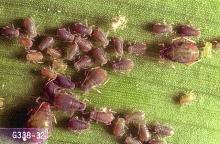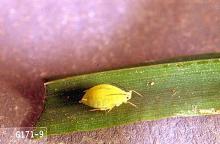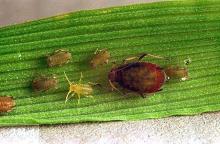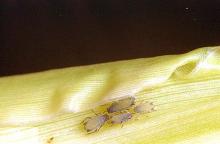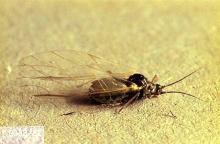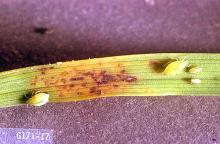Includes
Bird-cherry oat aphid (Rhopalosiphum padi)
Cereal grass aphid (Metopolophium festucae cerealium)
Corn leaf aphid (Rhopalosiphum maidis)
English grain aphid (Sitobion avenae)
Greenbug (Schizaphis graminum)
Rose-grass aphid (Metopolophium dirhodum)
Pest description and crop damage Aphids are of various colors-green, yellow, reddish. Cornicles, a pair of small tube-like structures on the posterior abdomen of aphids, are visible in most species, but may vary in size. Some species are important as vectors of barley yellow dwarf virus (BYDV), which can negatively impact yield and quality of small grains, especially winter wheat and winter barley. Attempts to reduce incidence of BYDV by controlling established populations of aphids have not been successful. Seed treatment insecticides of the neonicotinoid group have reduced BYDV incidence especially when used in combination with delayed fall planting.
Sampling and thresholds
To control aphids, insecticide application may be considered. However, management thresholds, albeit subjective, vary depending on the species. For some of the more damaging aphids, such as greenbug, an average from 5 to 15 aphids per tiller (or stem) at the seedling stage, and 10 to 25 aphids per stem after boot may require management. However, there is rarely a need to spray for aphids in small grains. Insecticide applications after grain is in the milk stage of ripening are of no value. In rare instances, foliar insecticide may need to be applied prior to harvest if the honeydew produced by heavy aphid presence could interfere with combine function.
Management-biological control
Occasionally aphids have been sufficiently abundant to cause localized damage to grain prior to grain fill, but usually they are held in check by predators and parasitoids.
Aphid predators and parasitoid wasps are important. Do not apply broad-spectrum foliar insecticides until you have examined the field for the presence of predators or parasitized aphids (a.k.a "mummified" aphids). Syrphid fly larvae and ladybird beetle larvae are common predators of value that reduce aphid populations; therefore, it is important to familiarize yourself with all developmental stages of these beneficial insects. The wasp Diaeretiella rapae is a common and effective parasitoid of Russian wheat aphid in intermediate rainfall in southeast Washington.
Management-chemical control
Some success has been achieved with systemic granules drilled in at fall seeding time for winter wheat. This practice helps prevent in-field multiplication and spread of aphids that may transmit BYDV. It does not prevent aphids from migrating into the wheat from other areas.
Some aphids such as bird cherry-oat aphid, English grain aphid and the Russian wheat aphid produce rolling on the leaves. Best control with insecticides is obtained before aphids begin to roll leaves.
Seed treatment
Seed treatments used on wheat and barley seed may provide some control of aphids:
- clothianidin (NipsIt Inside) at 0.75 to 1.79 fl oz (0.029 to 0.07 lb ai) /100 lb seed on-farm application. REI 12 hr. Do not exceed 0.2 lb ai/A clothianidin per year. Records of use as described in NZS 8409 Management of Agrichemicals must be kept if using 3 liters or more of NipsIt Inside within 24 hr.
- imidacloprid (Gaucho 600F) at 0.8 to 2.4 fl oz (0.031 to 0.094 lb ai) /100 lb seed. Do not graze or feed livestock on treated areas within 45 days after planting. REI 12 hr.
- imidacloprid/captan/carboxin (Enhance AW) at 4 oz per 100 lb seed. Do not graze or feed livestock on treated areas within 45 days after planting. REI 12 hr. Wheat, oats, barley.
- imidacloprid/metalaxyl/tebuconazole (Gaucho XT) at 3.4 to 4.5 fl oz (0.031 to 0.041 lb ai) /100 lb seed; early season protection. Do not graze or feed livestock on treated areas within 45 days after planting. REI 24 hr. Groundwater advisory: metalaxyl is known to leach through soil into groundwater under certain conditions as a result of agricultural use. Wheat, oats, barley.
- thiamethoxam (Cruiser 5FS) at 0.75 to 1.33 fl oz (0.029 to 0.052 lb ai) /100 lb seed; (Crusier Vibrance Quattro). REI 12 hr. Ground water advisory.
Foliar spray
Aphid control with foliar sprays is more successful when materials are applied during the warmer part of the day. Adequate coverage also is necessary: 5 gal water/A increases spray coverage and effectiveness.
- alpha-cypermethrin (Fastac CS) at 0.02 to 0.025 lb ai/A. PHI 14 days for grain, forage and hay. REI 12 hr. Retreatment interval 14 days. Do not exceed 0.075 lb ai/A per season. Wheat and triticale.
- azadirachtin (Aza-Direct, Ecozin 3EC) at 0.0125 to 0.043 lb ai/A. PHI 0 days. REI 4 hr. Best results can be obtained following 2 to 3 applications made at 7- to 10-day intervals. Some formulations are OMRI-listed for organic use.
- Beauveria bassiana GHA Strain ANT-03 (BioCeres WP) Check each label for application rate. PHI 0 days. REI 4 hr. OMRI-listed for organic use.
- beta-cyfluthrin (Baythroid XL, Sultrus) at 0.014 to 0.019 lb ai/A. PHI 30 days, 3 days for grazing or foraging. REI 12 hr. Retreatment interval 3 days. Do not exceed 0.038 lb ai/A per season. For best control, applications must be made before aphids damage the plants.
- Chromobacterium subtsugae (Grandevo WDG) at 0.6 to 0.9 lb ai/A. PHI 0 days. REI 4 hr. OMRI-listed for organic use.
- cyfluthrin (Tombstone) at 0.028 to 0.038 lb ai/A. PHI 30 days, 3 days for grazing or foraging. REI 12 hr. Retreatment interval 3 days. Do not exceed 0.076 lb ai/A per season of cyfluthrin alone, or the combined total of cyfluthrin plus beta-cyfluthrin. Wheat only.
- dimethoate (Dimate 4E, Dimethoate 400, 400 EC and EC) at 0.25 to 0.375 lb ai/A. PHI 35 days. REI 48 hr. Do not exceed 0.5 lb ai/A per season. Ground water advisory. Wheat only.
- fenpropathrin (Danitol 2.4EC) at 0.2 lb ai/A. REI 24 hr. Do not exceed 0.2 lb ai/A per season. One treatment per season. Apply before the boot stage of growth. Barley only.
- flupyradifurone (Sivanto 200 SL) at 0.09 to 0.18 lb ai/A. PHI 7 days forage; 21 days grain, stover or straw. REI 4 hr. Retreatment interval 7 days. Do not exceed 0.365 lb ai/A per year. Ground water advisory.
- gamma-cyhalothrin (Declare) at 0.01 to 0.015 lb ai/A. PHI 30 days, 7 days for grazing or foraging. REI 24 hr. Do not exceed 0.03 lb ai/A per season. Best control is obtained before insects begin to roll leaves.
- lambda-cyhalothrin (Silencer, Warrior II) at 0.02 to 0.03 lb ai/A. PHI 30 days, 7 days for grazing or foraging. REI 24 hr. Do not exceed 0.06 lb ai/A per season. Best control is obtained before insects begin to roll leaves.
- lambda-cyhalothrin/chlorantraniliprole (Besiege) at 0.059 to 0.098 lb ai/A. PHI 30 days, 7 days for grazing or foraging. REI 24 hr. Retreatment interval 7 days. Do not exceed 0.06 lb ai lambda-cyhalothrin or 0.2 lb ai chlorantraniliprole per year. Best control is obtained before insects begin to roll leaves.
- lambda-cyhalothrin/tebuconazole (Crossover) at 0.14 lb ai/A. PHI 30 days, 7 days for grazing or foraging. REI 24 hr. Do not exceed 0.11 lb ai/A tebuconazole or 0.06 lb ai/A lambda cyhalothrin per season. Do not exceed 8 fl oz/A or 0.139 lb ai/A per season. Barley, triticale and wheat.
- lambda-cyhalothrin/thiamethoxam (Endigo ZC) at 0.056 to 0.072 lb ai/A. PHI 30 days, 7 days for grazing or foraging. REI 24 hr. Retreatment interval 7 days. Do not exceed 0.06 lb ai/A lambda-cyhalothrin or 0.125 lb ai/A thiamethoxam per season. Groundwater advisory. Barley only.
- malathion (Malathion 8) at 1.0 lb ai/A. PHI 7 days. REI 12 hr. Retreatment interval 7 days. Limit 2 treatments per year. Barley, oat, rye and wheat.
- methomyl (Lannate SP) at 0.225 to 0.45 lb ai/A. PHI 7 days. REI 48 hr. Do not exceed 1.8 lb ai/A per season. Do not exceed 4 applications per season. Wheat only.
- pyrethrin-There are several pesticides containing various amounts of pyrethrins. Check each label for the use and amount needed. Some formulations are OMRI-listed for organic use.
- sulfoxaflor (Transform WG) at 0.023 to 0.047 lb ai/A. PHI 14 days grain or straw, 7 days grazing, forage, fodder, hay harvest. REI 24 hr. Retreatment interval 14 days. Do not exceed 0.09 lb ai/A per year. Limit 2 treatment per crop.
- thiamethoxam (Actara) at 0.0625 lb ai/A. PHI 21 days. REI 12 hr. Retreatment interval 7 days. Do not exceed 0.125 lb ai/A per year. Ground water advisory. Barley only.
- zeta-cypermethrin (Mustang, Mustang MAXX) at 0.04 to 0.05 lb ai/A. PHI 14 days for grain, forage, and hay. REI 12 hr. Retreatment interval 14 days. Do not exceed 0.25 lb ai/A (0.125 lb ai/A for Mustang Maxx) per year.


